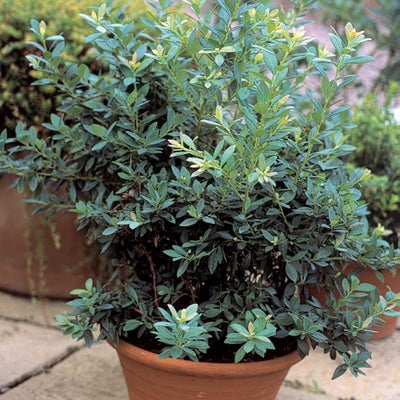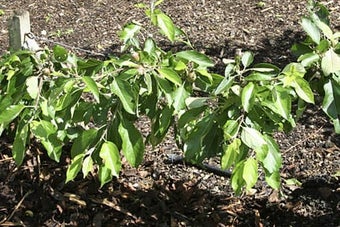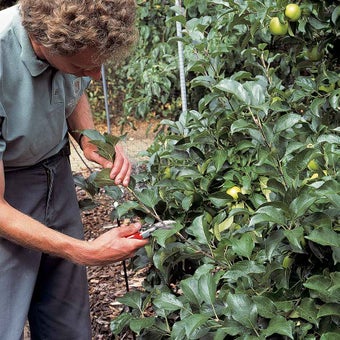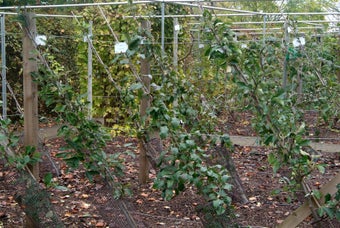
Quick facts
Suitable for - A range of fruit trees, vines and bushes
Planting time - Spring
Difficulty - Easy to moderate
Suitable for...
There’s a wide range of fruit that can be grown in pots.
All the tree fruits listed here will pollinate each other. However, the pollination group numbers (where applicable) are shown in brackets; aim to pick at least two trees of the same or adjacent-numbered pollination group. This matching of the groups is always done with the same fruit, such as apples, and will not work between different fruits such as apples and pears. These are just a few of the fruits suited to pot culture.
- Apples, culinary: ‘Arthur Turner’ (3), ‘Bountiful’ (3) and ‘Howgate Wonder’ (4)
- Apples, dessert/eating: 'Alkmene’ (2), ‘Discovery’ (3), Falstaff (3), ‘Fiesta’ (3) ‘Greensleeves’ (3), 'Kidd’s Orange Red’ (3), ‘Pixie’ (4) and 'Sunset' (3)
- Apricots: ‘Delicot’, ‘Tomcot’ and ‘Moorpark’ are self fertile*
- Blueberries: Most cultivars will grow well in pots, but particularly half-high blueberries such as ‘Northsky’, ‘Chippewa’ and ‘Northcountry’
- Cherries: ‘Lapins’, ‘Sunburst and ‘Stella’ are all self fertile (do not need another tree to pollinate them)
- Figs: ‘Brown Turkey’, ‘Brunswick’ and White Marseilles’ (no pollinators are required)
- Grapes: ‘Seyval Blanc’, ‘Siegerrebe’ and ‘New York Muscat’ (no pollinators are required)
- Nectarines: ‘Early Rivers’ and ‘Nectarella’ are self fertile*
- Olives:Olea europaea, O. ‘Aglandau’ and O. ‘Cailletier’ are fairly hardy and self fertile
- Peaches: ‘Duke of York’, ‘Garden Anny’, ‘Garden Lady’, ‘Peregrine’ and ‘Rochester’ are self fertile*
- Pears: ‘Beth’ (4), ‘Beurré Hardy’ (3), ‘Concorde’ (3), Conference (3), ‘Doyenné du Comice’ (4), ‘Glou Morceau’ (4) and ‘Red Comice’ (4)
- Plums: there are no suitable culinary cultivars, but the following dessert grow well in containers – ‘Blue Tit’, ‘Opal’ and ‘Victoria', which are self fertile
*These need to be hand pollinated when grown in a greenhouse or conservatory, by transferring pollen between flowers with a soft brush.
Choosing a rootstock
Once you have chosen which you want to grow, you will need to select the rootstock it grows on, at least for some fruit trees. The rootstock will help control the cultivar’s vigour and make it more suitable to grow in a container. Look on the label – you will often see there is a cultivar name with the rootstock printed next to it, such as Apple ‘Discovery’ M9.
These are the best options:
- Apple: M9, M26 (M27 is too dwarfing)
- Cherry: Colt or Gisela 5
- Pear: Quince C
- Plum, damson, peach, nectarine: Pixy or St Julien A
- Apricot: St Julien A or Torinel
Rootstocks are not required for blueberries, grapes, figs and olives.
Planting fruit in containers
As far as the type of container, clay pots are heavy and stable; plastic is durable, light and easier to manage. For most fruit, choose pots 45-50cm (18-20in) in diameter.
Fruit trees, vines and bushes can be planted in containers at any time of year. However, spring (March or April) is a particularly good time, as the roots soon grow and establish into the new .
When planting, place crocks (small pieces of broken clay pots) over the holes in the bottom of containers with large drainage holes to retain potting media during watering. Use a good-quality compost (John Innes No 3 is ideal), or multi-purpose compost mixed with one-third by volume grit or . Incorporate controlled-release fertiliser pellets, or feed fortnightly with a high-potassium liquid tomato feed.
Growing fruit in containers
Fruit in containers is usually a little more hassle than growing fruit in the open ground. Do keep the following in mind:
- Position fruit plants in full sun
- Water generously but allow the ’s surface to dry out before the next watering, without it becoming bone dry
- Leave hardy fruit outdoors over winter
- Peaches and apricots can be covered with a lean-to shelter from autumn to late winter to protect them from rain-splash and potential peach leaf curl
- To avoid the roots becoming pot bound, re-pot every year or alternate years after leaf fall. Once in its final pot, a plant can be root-pruned every other year with 30 per cent of the compost refreshed. In intervening years, replace the top layer of compost
Pruning and training
Fruit grown in pots is pruned just the same way as fruit grown in the open ground. See our individual plant and pruning profiles for further advice;
Apples and pears: pruning new trees
Apples and pears: summer pruning
Apples and pears: winter pruning
Apples and pears: espalier pruning
Fan-trained trees: initial training
Fan-trained trees: pruning established fans
Plum pruning
Fruit A-Z
Problems
Container-grown fruit needs careful watering throughout the summer to prevent the fruits dropping before they ripen, and the leaves browning around the edges.
There are some common problems to watch out for as well. These include apple canker, apple scab, bacterial canker, brown rot, peach leaf curl and silver leaf.
Take care not to overpot.





